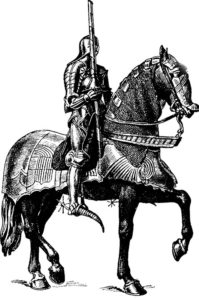 El Cid was the nickname given to Rodrigo Díaz de Vivar, a military leader born in 1043 near Burgos, Spain. El Cid is derived from the Arabic word sayyid meaning sir or lord. Rodrigo was born into a noble family and was raised in the court of King Ferdinand the Great (1015-1065). As a young man he served the king’s son, Sancho II and ascended to the level of commander when Sancho became king in 1065. He quickly became famous for his military prowess in particular in several campaigns against the Muslim Kingdoms in southern Spain in the area known as Al-Andaluz, modern day Andalusia.
El Cid was the nickname given to Rodrigo Díaz de Vivar, a military leader born in 1043 near Burgos, Spain. El Cid is derived from the Arabic word sayyid meaning sir or lord. Rodrigo was born into a noble family and was raised in the court of King Ferdinand the Great (1015-1065). As a young man he served the king’s son, Sancho II and ascended to the level of commander when Sancho became king in 1065. He quickly became famous for his military prowess in particular in several campaigns against the Muslim Kingdoms in southern Spain in the area known as Al-Andaluz, modern day Andalusia.
The Muslims had been in Spain since 711, and several campaigns and battles were fought for centuries before Spain regained full control of the peninsula in 1492. This prolonged campaign came to be known as the Reconquista. Sancho was assassinated in 1072 and the king’s brother, Alfonso assumed control. As a result, El Cid went into exile. While in exile, El Cid continued to fight in other areas of Spain, including Granada and Barcelona. King Alfonso ordered El Cid to return in 1087 after suffering a great defeat. Rodrigo took the opportunity to create his own principality near the city of Valencia by leading a combined army of Christians and Moors, in the victory of 1090. El Cid had married a woman named Jimena in 1075 and they had a son. El Cid lived a few peaceful years with his wife in his principality before this death in 1099.
El Cid was immortalized in a 12th century epic poem called El Canto del Mio Cid. This poem gives a partly fictionalized version of his life and portrays him as a chivalrous hero of the Reconquest of Spain. Through this poem El Cid reached a legendary status within the history of Spain and many plays, movies and other poems have been based on the story of his life. He is also commonly portrayed in paintings and statues, particularly near his hometown of Burgos.







